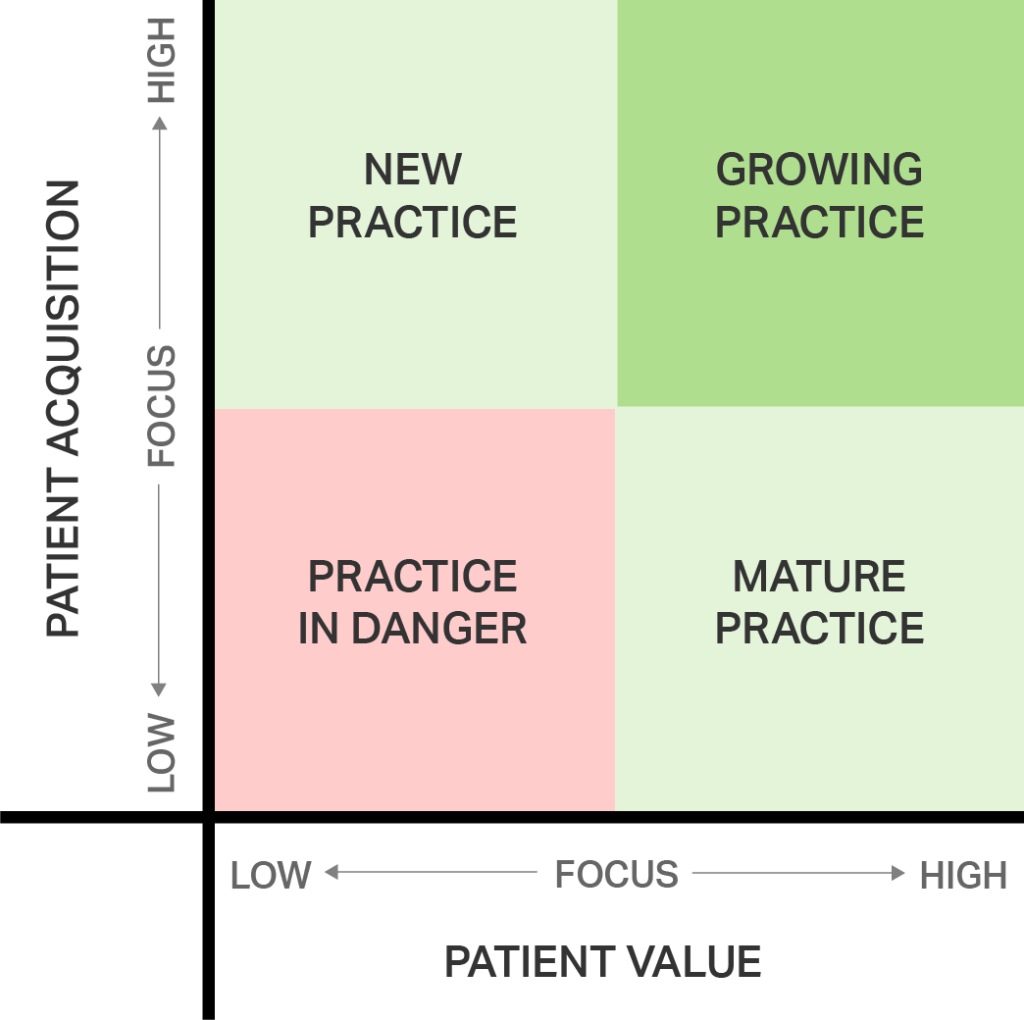
In terms of forecasting a healthcare practice’s financial health, lifetime value of patients (or LTV) is the most important statistic to understand. It is the single greatest indicator of growth, innovation, patient engagement and retention, and return on marketing spend.
To set the stage for interpreting patient LTV numbers, let me go back. In a previous post, How Patient Communication Preferences Impact Practice Costs and Revenues, a hypothetical example and actual example emphasize the impactive results good communication with patients can have on revenue.
Understanding LTV will supercharge both of those examples.
Two Examples (Refresher)
As a refresher, here is the hypothetical example:
Let’s assume our hypothetical medical practice, Superior Medical Clinic, has 10,000 patients in their database. Let’s also assume that each patient visit is worth $100 in revenue to the clinic.
What would it mean to Superior Medical Clinic to have 1% of their patients come in one more time a year? Well, the math is pretty simple:
- 1% of 10,000 = 100
- 100 more visits X $100 in revenue per visit = $10,000 more revenue
And here is the real-life example from one of our customers:
A medical clinic located in the heart of the Rocky Mountains asked RelevantMD to engage their current patients with the hope of generating incremental visits they would not have otherwise had.
Based on patient communication preferences, this clinic had RelevantMD use email, automated phone calls, and text to engage their database. Their statistics were not as clean and neat as those in our hypothetical example. They were, however, quite astounding.
Over three months, this clinic engaged 15,632 of their patients and generated 1,208 wellness checks, 667 physical exams, and 774 cholesterol checks. In other words, they got 16.9% of their patients to schedule an additional visit. Because of the mix of types of appointments, the average value per visit was $243 in revenue. That’s an additional $644,481 in revenue!
This clinic ended up spending $4.03 per visit. That’s a whopping 8,300% return on their marketing spend.
Any practice would be thrilled with a 8,300% return on marketing spend, right? But the story doesn’t really end there. Correctly interpreting patient LTV numbers makes the story much, much better.
Calculating LTV
So what is LTV and how do you calculate it?
LTV is a calculation of the value of a patient to a practice over the patient’s lifetime. In other words, how much revenue does one single patient generate over the course of years as a patient of the healthcare provider.
Let’s go back to our hypothetical and walk through a calculation.
Let’s say that on average, Superior Medical Clinic’s patients do the following:
- They join the clinic as a patient at age 25.
- They remain a patient for 12 years.
- They come in once a year for a wellness check. This visit brings in $100 in revenue to the clinic.
- They come in once a year when they are sick. For simplicity sake, this visit also brings in $100 in revenue to the clinic.
What is the LTV for patients of Superior Medical Clinic? We can calculate it with this formula.
Annual Revenue X Number of Years as A Patient = LTV
For Superior Medical Clinic, it is:
($100 (for the wellness check) + $100 (for the check when they are sick)) X 12 years
Or
$200 in Annual Revenue X 12 Years as A Patient = $2,400 LTV
The LTV of a Superior Medical Clinic patient is $2,400. In other words, to Superior Medical Clinic, every patient is worth $2,400.
LTV and Marketing
So how does the concept of LTV factor in with practice marketing decisions? Does it make a difference? Should it?
LTV has everything to do with marketing!
Before taking on any project for a customer, we ask them this question, “What is a new customer worth to you?” Another way of asking that question is, “What is your customer’s LTV?”
And we get funny reactions from our customers. Some see this question as a way for us to increase the cost of the campaign, as if we are saying, “Well, if a customer is worth $10,000, you wouldn’t mind paying more to get one, right?”
Some wonder if we have some angle and are trying to get data to share with their competitors. They think, “Why would you want to know that private information?” Again, not a worry. We wouldn’t have stayed in business for more than 23 years, like we have, if we betrayed our customers like that.
Most feel a bit sheepish because they have no idea what a new customer is worth to them. We can help them figure it out.
Why ask the question? The answer forms the foundation for understanding your return on marketing investment. For example, if you sell a widget for $100, you don’t want to be paying $10 per click in search engine marketing (SEM), especially when it takes 12 people clicking on your ad to get one sale (12 clicks X $10/click = $120 in marketing cost). Companies don’t last long with that kind of loss!
However, if you are selling a widget for a $100 annual subscription and your average customer stays on for 7 years, you will view that $120 marketing investment completely differently.
Correctly interpreting your LTV empowers you to make better strategic decisions on how to grow your practice.
A Strategic Choice Leading to More Revenue
With an understanding of how to calculate LTV, you are ready to talk strategy. There are two main levers to pull to increase revenue for any healthcare practice. You can either:
(A) Increase the number of patients you see.
Or
(B) Increase the LTV per patient.
Which is a better choice?
It completely depends on the stage your healthcare practice is in (see below).
- For healthcare practices who are just opening their doors, the better choice is to get new patients.
- For those healthcare practices who have accumulated enough resources and now want to grow aggressively, they will need to pull both levers.
- And for the mature practice who wants to ensure a healthy financial future, the focus must be on increasing patient LTV.
Consider the following chart:

The Significant Impact of LTV
Let’s return to our real life example. The healthcare clinic, located in the heart of the Rocky Mountains, that hired us had an 8,300% return on their marketing spend or $644,481 in one-time revenue. Given what we’ve discussed in this post, we know the story doesn’t end there. As if that one-time revenue isn’t enticing enough, it’s time to consider the impact on LTV for this clinic!
Remember, the visits generated by this campaign were incremental. In other words, they wouldn’t have happened without reaching out to the patients directly. Based completely on our experience, we can make the following assumptions:
- Since these patients would not have scheduled these visits without a nudge, they will require a nudge every time.
- Since these patients responded to the campaign once, they will respond again.
- We can use the national standards to set the cadence of all future campaigns. These standards dictate:
- A cholesterol check every five years.
- A physical exam every two years.
- A wellness visit every year.
- The average revenue and cost per visit will hold true for the next 15 years.
Putting it all together and extrapolating for only the next 15 years, we get the following calculation of LTV specifically for the patients who responded to this campaign.
- 774 cholesterol checks X $243 X 3 (or 1 visit for every five years for the next 15 years) = $564,246
- 667 physical exams X $243 X 7.5 (or 1 visit every two years for the next 15 years) = $1,215,608
- 1,208 wellness visits X $243 X 15 (or 1 visit every year for the next 15 years) = $4,403,160
To find the cost, we make the same calculation but substitute the cost in place of the revenue.
- 774 cholesterol checks X $4.03 X 3 (or 1 visit for every five years for the next 15 years) = $9,358
- 667 physical exams X $4.03 X 7.5 (or 1 visit every two years for the next 15 years) = $20,161
- 1,208 wellness visits X $4.03 X 15 (or 1 visit every year for the next 15 years) = $73,024
Adding it all together, we see that in addition to the $644,481 in immediate revenue, this campaign created $6,183,014 in LTV revenue at a cost of $102,543.
This healthcare practice will receive near ten times the amount of immediate revenue over the next 15 years, all from one campaign. That is as clear a picture on the impact of LTV as you can get!
The Power of LTV
Every practice administrator or executive needs to know the LTV of their patients. This knowledge is a critical block on which the practice’s growth strategy must be built. Knowing the LTV of an average patient will empower you to make decisions on how to allocate scarce resources (time and money) to either (or both) patient acquisition or patient retention. It will also give you precious insight into the financial health of your practice.
For practices who don’t know what the LTV of their average patient is, getting this knowledge is like turning on a light. It is one of the best parts of what we do for our customers.